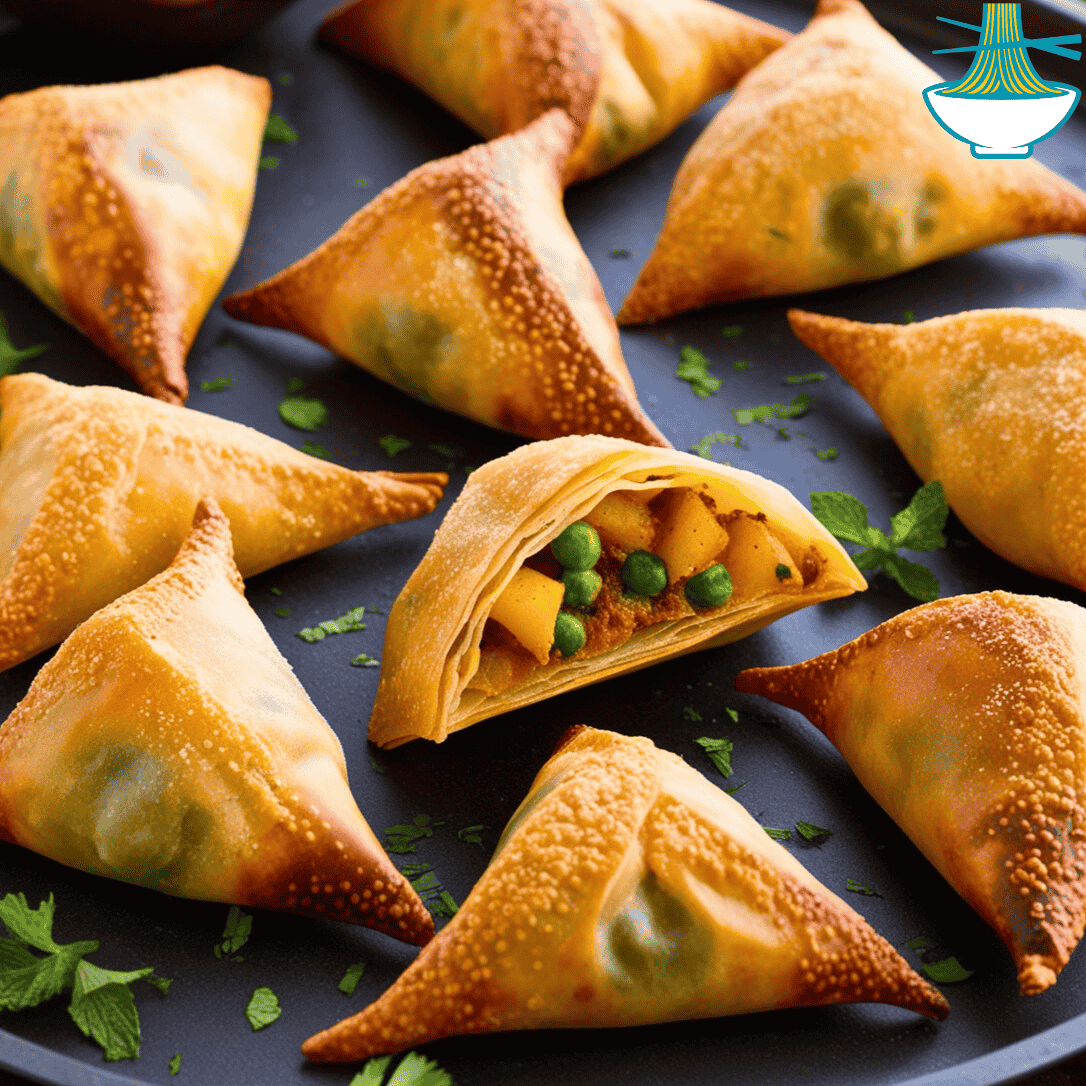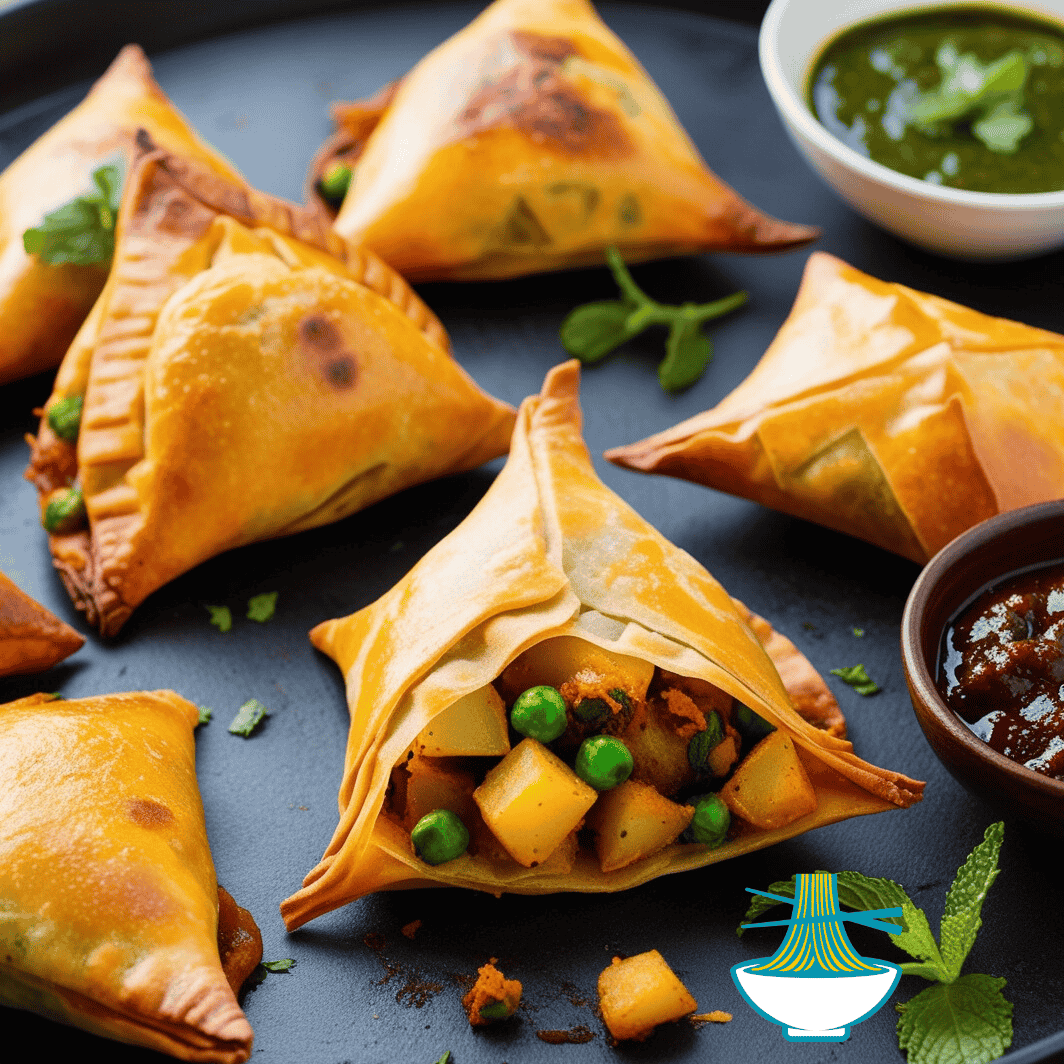Samosas are a beloved Indian snack known for their crispy, golden pastry and flavorful fillings. This homemade recipe offers a step-by-step guide to making delicious samosas, filled with spiced potatoes and peas, and fried to perfection. Whether you're enjoying them as a snack, appetizer, or party treat, these golden samosas pair wonderfully with chutneys like tamarind or mint. This vegetarian dish is perfect for any occasion and can even be baked for a healthier option without compromising on flavor.

Samosas have a rich history that dates back to the Middle East, where they were known as "Sambusak." They were introduced to India by traders and travelers from Central Asia around the 13th or 14th century. Over time, samosas became a staple in Indian cuisine, evolving with local flavors and ingredients. The Indian version of samosas is typically filled with spiced potatoes, peas, and sometimes meat. Samosas are now enjoyed worldwide, with each region offering its unique variation. They are especially popular as street food and during festivals and celebrations in India.
Ingredients:
- 2 cups all-purpose flour
- 1/4 teaspoon salt
- 1/4 teaspoon baking powder
- 4 tablespoons vegetable oil
- 1/2 cup water
- 2 medium potatoes, boiled and mashed
- 1/2 cup peas
- 1/2 cup onions, chopped
- 1 tablespoon grated ginger
- 1 tablespoon cumin seeds
- 1 tablespoon coriander powder
- 1/2 teaspoon turmeric powder
- 1/2 teaspoon red chili powder
- Salt to taste
- Oil for deep frying
Method:
1. Prepare the dough: In a bowl, mix flour, salt, and baking powder. Add the vegetable oil and mix until crumbly. Gradually add water, kneading into a smooth dough. Cover and let it rest for 30 minutes.
2. Make the filling: Heat oil in a pan and add cumin seeds. When they splutter, add onions and ginger, sauté until soft. Stir in peas, mashed potatoes, coriander, turmeric, chili powder, and salt. Cook for 2-3 minutes, then remove from heat and let it cool.
3. Shape the samosas: Divide the dough into small balls and roll each into a thin circle. Cut the circle in half. Form a cone by folding the straight edges together, sealing with water. Fill the cone with the potato mixture, and seal the top with water.
4. Fry the samosas: Heat oil in a deep pan. Fry samosas in small batches until golden brown and crispy. Drain on paper towels.
5. Serve: Enjoy hot with chutney or dipping sauce.

Nutrition Value:
1. 2 cups all-purpose flour
- Calories: 910
- Carbohydrates: 190g
- Protein: 24g
- Fat: 2g
- Sodium: 6mg
- Cholesterol: 0mg
- Vitamins: B vitamins (thiamine, niacin, folate)
- Minerals: Iron, magnesium, phosphorus
- Nutritional benefit: Provides energy through carbohydrates and essential nutrients for metabolism.
2. 1/4 teaspoon salt
- Calories: 0
- Carbohydrates: 0g
- Protein: 0g
- Fat: 0g
- Sodium: 575mg
- Cholesterol: 0mg
- Vitamins: None
- Minerals: Sodium
- Nutritional benefit: Enhances flavor and maintains fluid balance.
3. 1/4 teaspoon baking powder
- Calories: 0
- Carbohydrates: 0g
- Protein: 0g
- Fat: 0g
- Sodium: 5mg
- Cholesterol: 0mg
- Vitamins: None
- Minerals: None
- Nutritional benefit: Acts as a leavening agent for a lighter texture.
4. 4 tablespoons vegetable oil
- Calories: 480
- Carbohydrates: 0g
- Protein: 0g
- Fat: 56g
- Sodium: 0mg
- Cholesterol: 0mg
- Vitamins: Vitamin E
- Minerals: None
- Nutritional benefit: Provides healthy fats for energy and absorption of fat-soluble vitamins.
5. 1/2 cup water
- Calories: 0
- Carbohydrates: 0g
- Protein: 0g
- Fat: 0g
- Sodium: 0mg
- Cholesterol: 0mg
- Vitamins: None
- Minerals: None
- Nutritional benefit: Essential for hydration and forming the dough.
6. 2 medium potatoes, boiled and mashed
- Calories: 154
- Carbohydrates: 36g
- Protein: 4g
- Fat: 0g
- Sodium: 6mg
- Cholesterol: 0mg
- Vitamins: Vitamin C, B6
- Minerals: Potassium, magnesium
- Nutritional benefit: Provides carbohydrates for energy and supports heart health.
7. 1/2 cup peas
- Calories: 62
- Carbohydrates: 11g
- Protein: 4g
- Fat: 0g
- Sodium: 1mg
- Cholesterol: 0mg
- Vitamins: Vitamins A, C, K
- Minerals: Iron, magnesium, phosphorus
- Nutritional benefit: High in fiber and rich in vitamins for overall health.
8. 1/2 cup onions, chopped
- Calories: 32
- Carbohydrates: 7g
- Protein: 1g
- Fat: 0g
- Sodium: 3mg
- Cholesterol: 0mg
- Vitamins: Vitamin C, B6
- Minerals: Manganese, potassium
- Nutritional benefit: Contains antioxidants that promote heart health.
9. 1 tablespoon grated ginger
- Calories: 5
- Carbohydrates: 1g
- Protein: 0g
- Fat: 0g
- Sodium: 1mg
- Cholesterol: 0mg
- Vitamins: Vitamin B6
- Minerals: Magnesium, potassium
- Nutritional benefit: Known for anti-inflammatory properties and aids digestion.
10. 1 tablespoon cumin seeds
- Calories: 22
- Carbohydrates: 2g
- Protein: 1g
- Fat: 1g
- Sodium: 3mg
- Cholesterol: 0mg
- Vitamins: Vitamin E
- Minerals: Iron, manganese, magnesium
- Nutritional benefit: Supports digestion and provides iron.
11. 1 tablespoon coriander powder
- Calories: 24
- Carbohydrates: 4g
- Protein: 1g
- Fat: 1g
- Sodium: 3mg
- Cholesterol: 0mg
- Vitamins: Vitamin C, K
- Minerals: Potassium, manganese
- Nutritional benefit: Rich in antioxidants and may help lower blood sugar levels.
12. 1/2 teaspoon turmeric powder
- Calories: 4
- Carbohydrates: 1g
- Protein: 0g
- Fat: 0g
- Sodium: 2mg
- Cholesterol: 0mg
- Vitamins: Vitamin C
- Minerals: Iron, manganese
- Nutritional benefit: Contains curcumin with anti-inflammatory and antioxidant properties.
13. 1/2 teaspoon red chili powder
- Calories: 3
- Carbohydrates: 1g
- Protein: 0g
- Fat: 0g
- Sodium: 1mg
- Cholesterol: 0mg
- Vitamins: Vitamins A, C
- Minerals: Potassium
- Nutritional benefit: Contains capsaicin, which may boost metabolism.
14. Salt to taste
- Calories: 0
- Carbohydrates: 0g
- Protein: 0g
- Fat: 0g
- Sodium: Varies
- Cholesterol: 0mg
- Vitamins: None
- Minerals: Sodium
- Nutritional benefit: Enhances flavor; moderation is key.
15. Oil for deep frying
- Calories: Varies based on usage
- Carbohydrates: 0g
- Protein: 0g
- Fat: Depends on type and quantity
- Sodium: 0mg
- Cholesterol: 0mg
- Vitamins: Vitamin E (in some oils)
- Minerals: None
- Nutritional benefit: Adds flavor and texture; choose healthier oils for better nutrition.


Comments